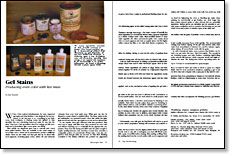
Synopsis: Fine Woodworking’s Jim Boesel tried out some gel stains and was surprised to discover they delivered on their marketing promises. He found them easy to apply, with little mess, producing an even color coat. Gel stains are fast-drying and don’t raise the grain much, and they covered a larger area than comparable portions of oil-base stains. Boesel talks about thickness through thixotropy and tells you how to apply gel stains. Side information by Gregory D. Johnson, a professional finisher, offers application tips.
When I first noticed advertisements for new, improved gel stains and clear finishes, I was skeptical, but not surprised. In the last year or so, everything in my bathroom, from toothpaste to shaving cream, has “gelled,” so why shouldn’t this new advertising buzzword make its way into the shop ? Next year, I had speculated, they’d be coming out with new, improved polyurethane light: covers great, less filling.
After awhile my skepticism gave way to curiosity and I tried these gelled finishes. They are available in the usual variety of wood stain colors, which can be intermixed to produce additional shades. There are also white and clear gels that can be tinted with most pigments, including Japan colors, artists’ oils and universal colorants from your local paint store. White gels can also be thinned to create a limed or pickled effect. The latest entries in the gel marketplace are premixed pastel colors that subtly tint tightgrain woods and color the open grain in woods such as oak and ash.
To my surprise, these gels delivered what they promised. They were easy to apply, with little mess. They produced an even color coat without requiring you to continually stir the pigment into suspension. They were fast drying and didn’t raise the grain enough to require sanding between coats. And they covered more area than a comparable portion of conventional oil-base stain. I was also surprised to learn that gel stains are not new. As Dick Fitch, finishing consultant to The Bartley Collection Ltd., pointed out, pigmented stains in paste form are at least as old as war paint, and wood finishers have been using them for centuries. Heavy-bodied wiping stains, which are thickened with additives that act something like cornstarch in gravy, have been a staple in professional finishing shops for decades. The thick consistency of these wiping stains keeps the pigment in suspension to provide predictable and repeatable results, but they have never been readily available to the weekend woodworker. Then about 20 years ago, gel stains made their appearance on the market. These new wiping stains owed their thick viscosity not to the addition of a thickening agent, as the earlier wiping stains had, but to rheology, the science of the deformation and flow of matter.
Thickness through thixotropy—Gel stains consist of basically the same ingredients as conventional oil-base stains: pigments suspended in a vehicle of alkyd resins (often alkyd-modified linseed or some other vegetable oil), driers and mineral spirits. Gels contain about twice as much pigment and resin as regular stains, but this higher solids content has little to do with their thicker consistency. So, what makes gel stains different from conventional wiping stains? The gels are thixotropic.
From Fine Woodworking #81
For the full article, download the PDF below:
Fine Woodworking Recommended Products


Bahco 6-Inch Card Scraper

Foam Brushes





















Log in or create an account to post a comment.
Sign up Log in